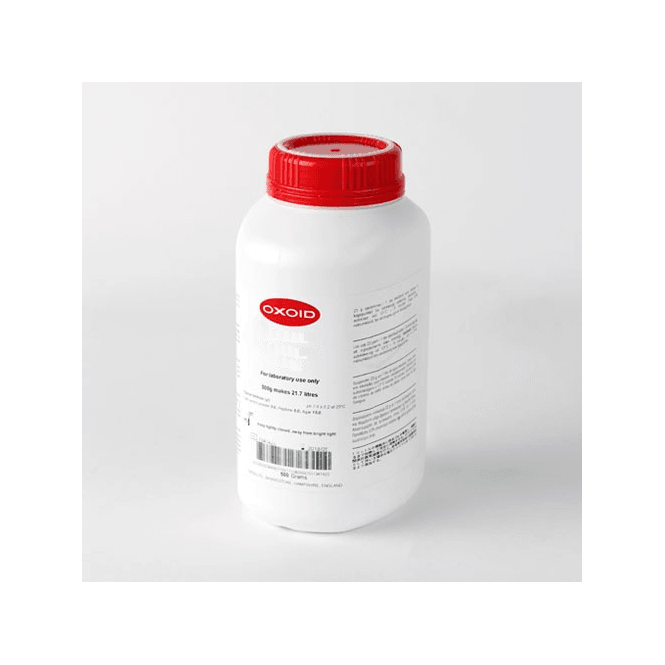Thermo Scientific™ Oxoid™ Bile Aesculin Agar (Dehydrated)
Catalog No :
CAS Number :
Brand :
In Stock
Specifications:
| Application | Microbiology | ||
| Storage Temperature | Ambient | ||
| Product Type | Culture Medium | Forms | Powder |
| Product Brand | Thermo Fisher Scientific™ | ||
| Product Grade | Microbiology grade | ||
Thermo Scientific™ Oxoid™ Bile Aesculin Agar is a differential and selective medium specifically designed for the isolation and presumptive identification of enterococci and Group D streptococci. This medium is widely recognized as an alternative to Lancefield grouping due to its ability to differentiate Group D streptococci based on bile tolerance and aesculin hydrolysis.
Key Features
- Selective for Enterococci and Group D Streptococci:
- Contains bile salts, which inhibit the growth of most Gram-positive bacteria other than enterococci and Group D streptococci.
- Differential Based on Aesculin Hydrolysis:
- Group D streptococci and enterococci hydrolyze aesculin to produce aesculetin and dextrose.
- Aesculetin reacts with ferric ions in the medium to form a dark brown or black precipitate, indicating a positive result.
- Easy-to-Read Results:
- The dark precipitate formed during aesculin hydrolysis provides a clear and visible indicator for positive organisms.
- Validated Alternative to Lancefield Grouping:
- The medium simplifies the presumptive identification process for Group D streptococci, as demonstrated by Swan (1954).
- High Specificity:
- Inhibits non-target Gram-positive bacteria while allowing growth of target organisms.
Specifications
| Property | Details |
|---|---|
| Product Name | Bile Aesculin Agar |
| Form | Powder |
| Product Type | Agar |
| Quantity | 500 g |
| Yield | 11.2 L of prepared medium |
| Target Organisms | Enterococci and Group D streptococci |
| Differentiation Basis | Aesculin hydrolysis and bile tolerance |
| Storage Conditions | Store at 10–30°C in a dry place |
| Shelf Life | Refer to label for expiration date |
| Appearance (Dehydrated) | Fine, light beige powder |
| Appearance (Prepared) | Light amber gel |
| Certifications/Compliance | Industrial Reference: FDA |
Preparation Directions
- Medium Preparation:
- Suspend 41.0 g of Bile Aesculin Agar powder in 1 liter of distilled water.
- Heat the mixture with frequent agitation to dissolve the powder completely.
- Boil for 1 minute to ensure the medium is fully dissolved.
- Do not autoclave; dispense the medium into sterile Petri dishes or tubes.
- Storage:
- Store prepared plates at 2–8°C. Avoid prolonged exposure to light.
Composition (Typical Formula per Liter)
| Component | Concentration (g/L) |
|---|---|
| Bile Salts | 40.0 |
| Peptone | 10.0 |
| Ferric Citrate | 0.5 |
| Aesculin | 1.0 |
| Agar | 15.0 |
| pH | 7.1 ± 0.2 at 25°C |
Applications and Use Cases
- Isolation and Presumptive Identification:
- Differentiates Group D streptococci (e.g., Streptococcus bovis) and Enterococcus species (e.g., Enterococcus faecalis, Enterococcus faecium) based on aesculin hydrolysis and bile tolerance.
- Clinical Diagnostics:
- Used in diagnostic microbiology for identifying enterococcal infections in fecal, urine, and blood specimens.
- Enterococci are significant as both commensal flora and opportunistic pathogens in human infections, including UTIs and endocarditis.
- Food and Water Testing:
- Applied in food and water microbiology to detect enterococci as indicators of fecal contamination.
- Research Applications:
- Supports studies on the resistance and pathogenicity of Enterococcus species, particularly in healthcare settings.
Result Interpretation
| Organism | Growth | Aesculin Hydrolysis | Appearance |
|---|---|---|---|
| Enterococcus faecalis | Good growth | Positive | Black/brown precipitate |
| Group D Streptococcus (e.g., S. bovis) | Good growth | Positive | Black/brown precipitate |
| Other Gram-positive bacteria | Inhibited | Negative | No growth/clear medium |
| Escherichia coli | Inhibited | Negative | No growth |
Advantages
- High Specificity:
- Effectively differentiates target organisms from other Gram-positive bacteria.
- Clear Visual Identification:
- Aesculin hydrolysis produces a distinct black/brown precipitate.
- Selective Inhibition:
- Bile salts selectively suppress non-Group D Gram-positive bacteria.
- Easy Preparation:
- Dehydrated medium simplifies lab workflows.
- Validated Diagnostic Tool:
- A widely accepted alternative to Lancefield grouping.
Storage and Shelf Life
- Dehydrated Medium: Store at 10–30°C in a dry location.
- Prepared Medium: Store at 2–8°C for up to 3 days.
References
- Facklam R. R. and Moody M. D. (1970). Appl. Microbiol. 20, 245-250.
- Isenberg H. D., Goldberg D., and Sampson J. (1970). Appl. Microbiol. 20, 433-436.
- Swan A. (1954). J. Clin. Path. 7, 160-163.
The Thermo Scientific™ Oxoid™ Bile Aesculin Agar offers a reliable and efficient method for isolating and differentiating enterococci and Group D streptococci, making it a valuable tool for clinical, food, and water microbiology laboratories. Let me know if further details or comparisons are needed!




 0
0
